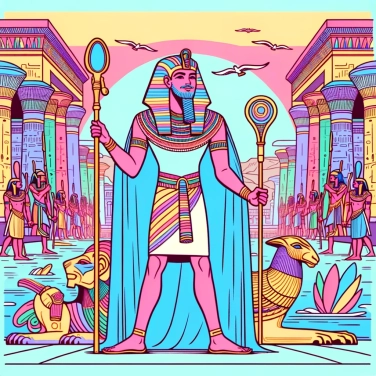In detail, for those interested!
Power and legitimacy
Hatshepsut acquired power as pharaoh based on a mixture of dynastic legitimacy and administrative competence. As the daughter of pharaoh Thutmose I and the wife of her half-brother Thutmose II, she claimed the throne upon his death to ensure the continuity of the royal lineage. Although she initially acted as regent for her stepson Thutmose III, she gradually consolidated her authority and was ultimately crowned pharaoh in 1473 BC, under the name Maatkare. Her position was based on strong dynastic foundations, supported by the priests and elites of the time.
Her legitimacy as pharaoh was also strengthened by her promotion of traditional Egyptian religious cults, particularly as a representative of the goddess Hathor. Hatshepsut sought to present herself as a skilled and benevolent leader, concerned with the well-being of her people and the prosperity of Egypt. She oversaw ambitious construction projects, including the funerary temple of Deir el-Bahari in Thebes, which reflected her power and authority as a sovereign.
Ultimately, Hatshepsut consolidated her power by cleverly combining dynastic legitimacy, administrative competence, and astute political strategies to become one of the few women to rule as a pharaoh in ancient Egypt.
Political Strategies
Hatshepsut implemented several political strategies to consolidate her power as pharaoh. First, she relied on her legitimacy as a member of the royal family. By partnering with Thutmose II, her half-brother and husband, she legitimized her status as queen. After Thutmose II's death, she acted as regent for their young son Thutmose III, thus consolidating her position within the royal family.
To strengthen her legitimacy as pharaoh, Hatshepsut carefully crafted propaganda to legitimize her seizure of power. She associated her reign with the will of the gods by presenting herself as the incarnation of the goddess Hathor, the goddess of love, joy, and motherhood. This divine connection bolstered her legitimacy in the eyes of the Egyptian people.
Furthermore, Hatshepsut adopted skillful diplomatic practices to maintain stability and consolidate her power. She formed alliances with other kingdoms and sent commercial expeditions to Nubia and the Levant to strengthen Egypt's economy. These alliances and trade exchanges helped solidify her authority as pharaoh.
Lastly, Hatshepsut initiated ambitious construction projects, such as the temple of Deir el-Bahari in Luxor, to assert her greatness and power as pharaoh. These monumental achievements helped reinforce her image as a powerful and visionary leader, thus consolidating her political power.
Image and representation
As pharaoh of Egypt, Hatshepsut used various strategies to consolidate her power and maintain her image as a legitimate leader. To strengthen her legitimacy, she adopted a masculine representation in her art and monuments. Hatshepsut was often depicted with a false beard, a traditional attribute associated with male pharaohs, in order to reinforce her authority and legitimacy as a ruler. This iconographic representation emphasized her role as a sovereign and aimed to reassure the people about her ability to govern.
Statues and bas-reliefs depicting her as a man were designed to reflect the strength and power associated with the pharaonic figure. Hatshepsut also made sure that her image was associated with deities such as Amun, to strengthen her divine legitimacy as a pharaoh. This strategy aimed to consolidate her power by ensuring that her reign was accepted by the clergy and the Egyptian population.
Despite her representation as a man, Hatshepsut was also aware of the importance of preserving her feminine identity. Some of her monuments depict her with feminine characteristics, highlighting her duality as a woman assuming the role of a pharaoh. This combination of male and female elements in her iconography helped forge a complex and unique image of Hatshepsut as a leader.
In summary, the image and representation of Hatshepsut as a pharaoh were carefully designed to strengthen her legitimacy and authority as the sovereign of Egypt. Her combination of masculine and feminine attributes in her iconography demonstrates her ability to play with the social conventions of the time to consolidate her power and establish her reign.
![Explain why some countries change time zones?]()
![Explain why Alexander the Great refused to wear shoes.]()
![Explain why Alexander the Great always wore an impressive helmet.]()
![Explain why the last Chinese emperor was so young when he came to power?]()




















